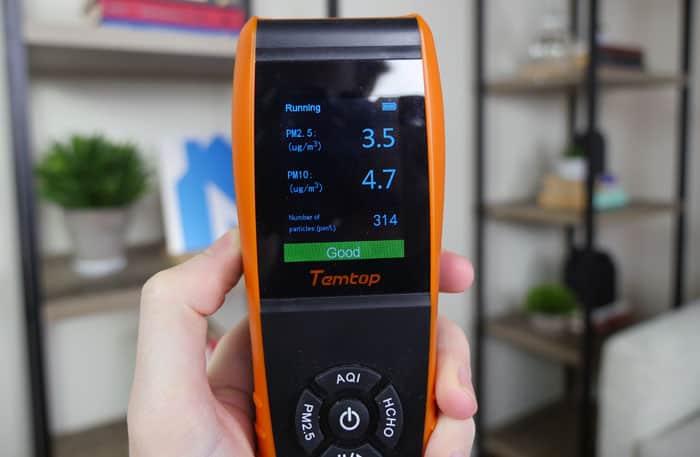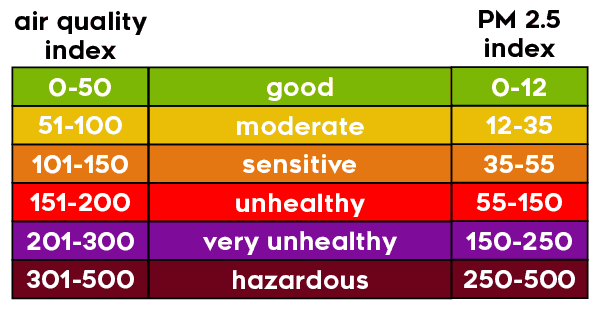
Best For
- Emergency air purification situations (i.e. health crisis, wildfires)
- Cheap and easy alternative to expensive air purification systems
- Post Apocalyptic World Order
Considerations
- No Remote or App connectivity
- System is more fragile being held together with duct tape
- Not aesthetically appealing
Our Verdict
The Corsi Rosenthal Box is a fast and efficient DIY air purifier alternative. It was first introduced in 2020 during the COVID-19 pandemic by Richard Corsi to help families create additional clean air circulation in their homes. The design is simple enough for anyone to assemble and uses 4 HEPA filters with a standard home box fan.
While this DIY project isn’t the prettiest to look at, it does have exceptional purification performance with the correct air filters. In our tests, it was able to reduce PM2.5 to 0.1. However, its loud operating noise, size, and DIY-nature may make it undesirable for some
Filter Type: HEPA Filters
Coverage Area: Unknown
CADR: Unknown
In This Review
Purification Performance | Filters | Noise Test | Usability | Maintenance | Size | Comparison
To build your own DIY air purifier you’ll need the following supplies:
- 20″ box fan
- Pack of 4 20″ HEPA filters (MERV 13, ideally)
- Duct tape
Performance Summary
At Modern Castle we test 8 different factors that impact the performance, build quality, and usability of the air purifier. Below is a complete list of our testing categories and their performance.
| Test Type | Test Data |
|---|---|
| PM2.5 (2 hour test) | 0.1 ppm |
| PM10 (2 hour test) | 0.1 ppm |
| Particles (2 hour test) | 35 |
| AQI (2 hour test) | 2 |
| Filter Type | HEPA |
| Coverage Area | Unknown |
| CADR | Unknown |
| Max Wind Speed | 9.2 mph (14.8 kph) |
| Noise Test | 68.7 dB |
Purification Performance
Our purification test for the Corsi box involved testing 2 different versions of the DIY air purifier. The first version is more basic and uses only the box fan and a single filter strapped to the back. The second version uses the standard configuration for the Corsi box, minus the cutout shroud.
To test both iterations of the Corsi Box, we placed it in a medium-sized room in our office (~14’ x 10`). Next, we lit incense to introduce smoke and other particulates into the air for 30 seconds. After, we use a professional air quality detector to take a measurement of the smoke filled air.

Next, we run the air purifier on the highest fan speed for 2 hours, taking measurements of the air quality at the one hour mark and the end of the test. Here is what we found:
| Performance Metric | Starting Measurement | After 1 Hour | After 2 Hours |
|---|---|---|---|
| PM2.5 | 26.1 ppm | 0.1 ppm | 0.1 ppm |
| PM10 | 42.3 ppm | 0.1 ppm | 0.1 ppm |
| Particles | 2276 | 54 | 35 |
| AQI | 124 | 2 | 2 |
Surprisingly, both our super simple single HEPA strapon version and proper Corsi box showcased great results, with the 4-filter Corsi Box outperforming many other manufactured air purifiers we have tested to date.
After the first hour, the 4-filter Corsi box performed at the same level as many of the high-end air purifiers we have tested. Within the first hour, the Corsi Box reduced both PM2.5 and PM10 to 0.1 ppm, and Air particulates from 124 down to 54, beating our testing average by 7 points.

The single filter HEPA version wasn’t quite as good, reducing PM2.5 to 2.7 and PM10 to 4.7 after the first hour. While that isn’t perfect performance it is still well within healthy breathing levels. After the second hour the air quality improved further, with PM2.5 at 0.4 and PM10 at 0.8. Given the simplicity, cost, and footprint it’s hard to not be impressed.
Below, we’ve included information on the testing criteria and what defines good vs. bad air quality. Simply, the lower the numbers the better.

Filters
The filters to make a Corsi Box are standard square HEPA filters. These are the same types of filters you can use an HVAC system. The filters we used are MERV 13 and are 20 by 20 by 1 inch. We bought this size so it would match our 20 inch box fan.

HEPA Filters – HEPA stands for High Efficiency Particulate Air [filter], which is common in most modern air purifiers. HEPA filters are able to capture particles as small as 0.3 microns.
Wind Speed Test
Our wind speed test uses an anemometer placed directly on the air vents of the Corsi Box to measure the fan speeds in miles per hour. We run it on the lowest and highest fan speeds and record the speed of the air coming out of the device.
Minimum Wind Speed
6.9 mph
Maximum Wind Speed
9.2 mph
Our Corsi Box had a maximum wind speed of 9.2 mph, which is 2.88 mph lower than our testing average of 12.08 mph. On its lowest setting we measured it at 6.9 mph, which is 3.13 mph faster than our testing average of 3.77 mph.

Noise Test
To determine the level of noise that the Corsi Box creates we use a sound meter and measure the decibel levels on both the lowest and highest fan speeds. In addition, we measure the ambient noise levels of the room as a baseline comparison.
Ambient Noise
39.8 dB
Min Noise
60.0 dB
Max Noise
68.7 dB
This DIY air purifier is not built for its noise discretion. Depending on the fan model that you choose, it may lower or increase the noise output. Our specific testing model produced 68.5 dB when measured on its max setting. This is 6.55 db louder than our testing average of 61.95 db. Making it tied for 4th place as the loudest air purification system we have tested to date.

Usability
With this being a DIY project, depending on the fan you use could impact its usability. Our specific testing fan was super simple.
Setup
Setup is not like other assembled air purifiers. This is a DIY purifier and requires some assembly. In total, the box took about 15 minutes to set up and assemble. You will need the 4 HEPA filters, a box fan, and lots of duct tape.

As mentioned previously, we created two different versions of DIY air purifierThe single-filter version is quite easy, requiring the user to place the filter against the back of the box fan. Make sure the air is flowing through the filter and into the box fan and seal the edges with duct tape.
For the 4-filter Corsi Box, you’ll need to seal all the filters together with duct tape as pictured below, with the air flowing through the filters and then into the fan. We found it easiest to position the fan face down and assemble the filters on top of it.

In addition, you’ll want to make sure you have a good seal between the filters and the box fan. The job doesn’t have to be pretty, but the better the sealing the better performing the Corsi Box. Furthermore, I would suggest using a piece of cardboard from the fan packaging as the bottom for the Corsi Box.
Controls & Display
The controls are simple on the box we made. There is a dial that changes the fan’s speed through three different speed levels. However, depending on the box fan you choose, there may be more fan speed settings.

Maintenance
The Corsi Box has an estimated yearly maintenance cost of $94. The following are the major maintenance tasks for the DIY Corsi Box.
| Task | Description | Est. Annual Cost |
|---|---|---|
| HVAC Filters | Replace as needed (every 6-12 months) | $86 |
| Duct Tape | Replace when replacing HVAC filters | $8 |
| Box Fan | Periodically clean and dust | $0 |
Keep in mind, that the HVAC estimated replacement cost assumes they will need to be replaced every 6 months. This could be more or less frequent depending on usage and environment.
Size & Dimensions
The Corsi box is fairly large, compared in size to many large manufactured air purifiers. Depending on your construction, choice of box fan, and choice of filters the size may vary.
| Attribute | Measurement |
|---|---|
| Height | 21.5″ (55 cm) |
| Length | 24.0″ (61 cm) |
| Width | 20.5″ (52 cm) |
| Weight | 13.3 lbs. (6 kg) |
DIY Air Purifier vs. Air Purifier
Below is a complete list of our air purifier tests and critical product data compared side by side to the average based on all of our air purifier tests to date.
| Test Type | Test Data | Avg. Data |
|---|---|---|
| PM2.5 (2 hours) | 0.1 ppm | 0.2 ppm |
| PM10 (2 hours) | 0.1 ppm | 0.3 ppm |
| Particles (2 hours) | 35 | 45 |
| AQI (2 hours) | 2 | 1 |
| Ozone Detected | 0.0 ppm | 0.0 ppm |
| Filter Types | HEPA | n/a |
| Coverage Area | Unknown | 727 sq. ft. |
| CADR | Unknown | 289 CFM |
| Max Wind Speed | 9.2 mph | 12.1 mph |
| Noise Test | 68.7 dB | 62.1 dB |
For being extremely affordable and easy to build, this DIY project had exceptional performance when measured against some of the high end air purifiers we have tested to date.
Summary
The biggest advantage of the Corsi box or even the more simple single filter setup is the cost. All together you can keep this air purifier to around $70. If you get a more impressive box fan and/or higher end filters, that cost could go up. In any case, it’s going to be cheaper than many air purifiers on the market.
In terms of performance, both DIY air purifiers we built did really well, with the Corsi box being on par with most other high end purifiers we test.
The negative of a system like this is it requires assembly, requires disassembly and reassembly every time you need to change the filters, is fairly large, quite loud, and in my view, pretty ugly. Nevertheless, the performance is good. If those cons aren’t important to you then building a DIY air purifier can be a great fit.
